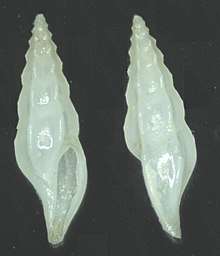Ithycythara lanceolata
| Ithycythara lanceolata | |
|---|---|
 | |
| Shell of Ithycythara lanceolata | |
| Scientific classification | |
| Kingdom: | Animalia |
| Phylum: | Mollusca |
| Class: | Gastropoda |
| Clade: | Caenogastropoda |
| Clade: | Hypsogastropoda |
| Clade: | Neogastropoda |
| Superfamily: | Conoidea |
| Family: | Mangeliidae |
| Genus: | Ithycythara |
| Species: | I. lanceolata |
| Binomial name | |
| Ithycythara lanceolata (C. B. Adams, 1850) | |
| Synonyms[1] | |
| |
Ithycythara lanceolata, common name the spear mangelia, is a species of sea snail, a marine gastropod mollusk in the family Mangeliidae.[1]
Description
The length of the shell varies between 4 mm and 20 mm.
(Original description) The shell is very long and has a lanceolate shape. It is brownish, more or less tinged with purple, with fine spiral lines of white and of dark brown, which are more conspicuous on the ribs; with a darker and wider brown line along the suture. The longitudinal sculpture consists of six very prominent acute transverse ribs on each whorl, which are nearly or quite continuous on the successive whorls. There is a spiral elevated line, on the middle of the whorls, which is obsolete in the intercostal spaces and has nodtdous intersections with the ribs. The protoconch is acute. The spire shows rectilinear outlines. The shell contains 8 whorls, scarcely convex, with a lightly impressed suture. The outer lip is finely denticulate within. The sinus is shallow. The siphonal canal is not very short.[2]
Distribution
I. lanceolata can be found in Atlantic waters, ranging from the eastern coast of Florida south to Brazil.;[3] in the Caribbean Sea, the Gulf of Mexico and the Lesser Antilles.
Habitat
Depth range based on 5 specimens in 1 taxon.
Water temperature and chemistry ranges based on 1 sample.[4]
Environmental ranges
Depth range (m): 2.75 - 18 Temperature range (°C): 23.720 - 23.720 Nitrate (umol/L): 0.501 - 0.501 Salinity (PPS): 36.080 - 36.080 Oxygen (ml/l): 4.807 - 4.807 Phosphate (umol/l): 0.100 - 0.100 Silicate (umol/l): 0.805 - 0.805[4]
References
- 1 2 Ithycythara lanceolata (C. B. Adams, 1850). Retrieved through: World Register of Marine Species on 8 August 2011.
- ↑ Adams, C. B. 1850. Description of supposed new species of marine shells which inhabit Jamaica. Contributions to Conchology, 4: 56-68, 109-123

- ↑ Tunnell, John W., Jr., Felder, Darryl L., & Earle, Sylvia A., eds. Gulf of Mexico Origin, Waters, and Biota, Volume 1: Biodiversity. Texas A&M University Press, 2009. 666.
- 1 2 http://eol.org/pages/456391/details#Description
External links
- Rosenberg, G., F. Moretzsohn, and E. F. García. 2009. Gastropoda (Mollusca) of the Gulf of Mexico, Pp. 579–699 in Felder, D.L. and D.K. Camp (eds.), Gulf of Mexico–Origins, Waters, and Biota. Biodiversity. Texas A&M Press, College Station, Texas
- Tucker, J.K. 2004 Catalog of recent and fossil turrids (Mollusca: Gastropoda). Zootaxa 682:1-1295.
- Gastropods.com: Ithycythara lanceolata
- Specimen at MNHN, Paris